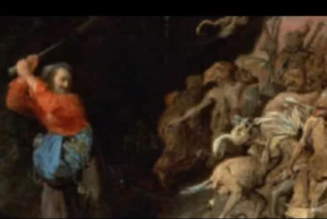
Each of the four cardinal elements – earth, air, fire and water – can be incorporated into magical practice and ritual. Depending on your needs and intent, you may find yourself drawn to one of these elements more so that the others.
Connected to the North, Earth is considered the ultimate feminine element. The Earth is fertile and stable, associated with the Goddess. The planet itself is a ball of life, and as the Wheel of the Year turns, we can watch all the aspects of life take place in the Earth: birth, life, death, and finally rebirth.
The Earth is nurturing and stable, solid and firm, full of endurance and strength. In color correspondences, both green and brown connect to the Earth, for fairly obvious reasons! In Tarot readings, the Earth is related to the suit of Pentacles or Coins.
Let’s look at some of the many magical myths and legends surrounding earth.
EARTH SPIRITS
In many cultures, earth spirits are beings that are tied to the land and plant kingdom. Typically, these beings are associated with another realm, the forces of nature that inhabit a particular physical space, and landmarks like rocks and tees.
In Celtic mythology, the realm of the Fae is known to exist in a parallel space with the land of man. The Fae are part of the Tuatha de Danaan, and live underground. It’s important to watch out for them, because they’re known for their ability to trick mortals into joining them.
Gnomes feature prominently in European legend and lore.
Although it’s believed that their name was coined by a Swiss alchemist named Paracelsus, these elemental beings have long been associated in one form or another with the ability to move underground.
Likewise, elves often appear in stories about the land. Jacob Grimm collected a number of stories about elves while compiling his book Teutonic Mythology, and says that elves appear in the Eddas as supernatural, magic-using beings.
They appear in a number of old English and Norse legends.
THE MAGIC OF THE LAND
Ley lines were first suggested to the general public by an amateur archaeologist named Alfred Watkins in the early 1920s. Ley lines are believed to be magical, mystical alignments in the earth. One school of thought believes that these lines carry positive or negative energy. It is also believed that where two or more lines converge, you have a place of great power and energy. It is believed that many well-known sacred sites, such as Stonehenge, Glastonbury Tor, Sedona and Machu Picchu sit at the convergence of several lines.
In some countries, spirits associated with various landmarks became minor, localized deities. The ancient Romans accepted the existence of genius loci, which were protective spirits associated with specific locations. In Norse myth, the Landvættir are spirits, or wights, directly associated with the land itself.
Today, many modern Pagans honor the spirits of the land by celebrating Earth Day, and use it as a time to reaffirm their roles as stewards of the earth.
DEITIES ASSOCIATED WITH EARTH
If you’re hoping to do an earth meditation or ritual, you can honor some of the different gods and goddesses associated with the land.
If you follow a Celtic-based path, consider reaching out to Brighid or Cernunnos. In the Roman pantheon, Cybele is a mother goddess who is associated with the earth. For Greek or Hellenic Pagans, Dionysus or Gaia might be appropriate to call upon. If your belief is more along the lines of Egyptian or Kemetic reconstruction, there’s always Geb, who is associated with the soil. Do you have an interest in Hawaiian gods and goddesses? Consider working with Pele, who is associated not only with volcanoes, but with the islands themselves.








